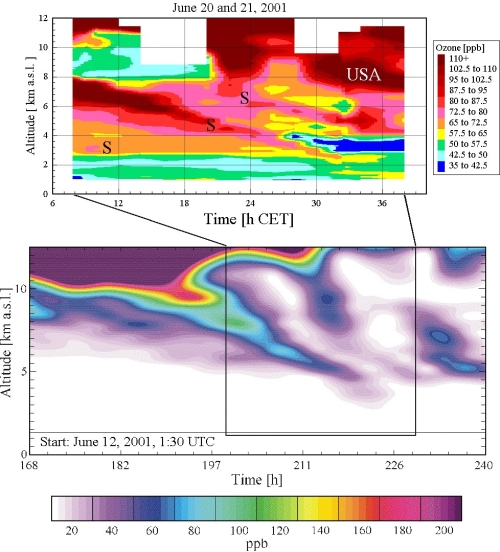Results: Transport of Stratospheric Ozone into the Troposphere
Contact: Thomas Trickl
Since 1996 focussed measurements with the IMK-IFU ozone lidar during predicted stratospheric air intrusions into the troposphere (see figure below) have yielded a very high probability of deep intrusions to reach the Zugspitze summit where they have been observed over several decades (VOTALP ![]() , STACCATO
, STACCATO ![]() and ATMOFAST projects). From the long-term measurements at the summit station a positive trend of the stratospheric component since the mid-seventies has been determined that has resulted in a surprisingly high stratospheric fraction of the ozone at 3000 m. The lidar measurements have also served as a reference for numerical model simulations. There are, still, important deficiencies in the results of quite a few coarse-grid models used for hemispheric and global studies, which prevents a full quantification of stratosphere-troposphere exchange.
and ATMOFAST projects). From the long-term measurements at the summit station a positive trend of the stratospheric component since the mid-seventies has been determined that has resulted in a surprisingly high stratospheric fraction of the ozone at 3000 m. The lidar measurements have also served as a reference for numerical model simulations. There are, still, important deficiencies in the results of quite a few coarse-grid models used for hemispheric and global studies, which prevents a full quantification of stratosphere-troposphere exchange.

Lidar measurements (upper panel) during a complex intrusion case in June 2001, showing three descending stratospheric layers (S); two of these intrusions were nicely reproduced with the fine-grid FLEXPART ![]() transport model (lower panel), the third one (morning of June 20) originated outside the model domain. "USA" denotes ozone import from the United States.
transport model (lower panel), the third one (morning of June 20) originated outside the model domain. "USA" denotes ozone import from the United States.
Reference:
P. Zanis, T. Trickl et al.: Forecast, observation and modelling of a deep stratospheric intrusion event over Europe, , Atmos. Chem. Phys., 3, 763-777, 2003